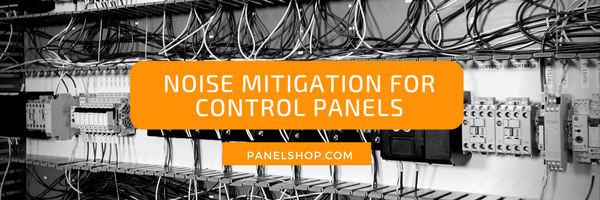
Electromagnetic Interference is a common phenomenon in a world which is embedded with electrical circuits. In a nutshell, EMI or Radio-frequency Interference is a disturbance that is generated by an external source like power lines, variable frequency drives, magnetic contactors, etc. effecting electrical circuits in its proximity.
With the increasing requirements for space saving control panels, the risk of Electromagnetic Interference is bound to increase, adding complexity to their designs & shielding techniques.
Increased EMI adversely affect manufacturing industries’ control panels by lowering system efficiency and interfering with ethernet transmissions, which is the cornerstone of every automated unit. Initial design stages often ignore this issue; however, it only gets more annoying once EMI starts altering your system’s outputs. Therefore, it is imperative that noise mitigation solutions be integrated within a control panel or enclosure during the design process, in order to prevent:
- Productivity loss
- Downtime
- Device, Repair & Troubleshooting costs
Electromagnetic compatibility is a machine’s ability to operate within electromagnetic radiations, through a shielding mechanism. Too often, ethernet switches interfere with equipment installed within control panels that don’t have the necessary electromagnetic compatibility, effecting the communications’ robustness, reliability and maintainability. This downgrades a company’s product, even though it possesses all the necessary specifications & features required for top-notch operation. If, however sufficient Noise Mitigation was installed beforehand, the equipment would have performed as promised, and not a single related problem would have erupted.
Protection against EMI has developed over the years, but continues to follow the basic principle introduced by the Faraday Cage. A metal enclosure around all electrical components isolates it from the outside world, effectively sealing any EMI coming in or going out of the component. Practically speaking, this is not possible. Enclosures need to have access points so that they can be turned on/off, altered, etc. while allowing cables to go through. This makes a “sealed metal enclosure” something quite far from reality.
Access points like those described above create leaks for EMI, allowing specific frequencies to pass through, depending on the size of the leak. Altering the design of the steel enclosure can mitigate the problem by over 80%, which is the motivation behind Hoffman’s CONCEPT & INLINE family of enclosures.
The standard environmental gasket is the foremost access point for high frequency EMI. Hoffman solutions upgrade the enclosure’s ability to attenuate the high frequency interference by increasing the shielding of the gasket.
The EMC version of the INLINE family makes use of a metalized non-woven fabric EMI material, attenuating a signal by 50dB at 1Ghz. On the other hand, the external components of the PROLINE EMC have a painted exterior that can attenuate over 34dB at 1GHz.
What is attenuation?
It is the reduction of electromagnetic energy after it passes through a certain distance or material. A standard metal enclosure can attenuate a signal by 20dB at 1Ghz.
Altering the environmental gasket however reduces the environmental type rating of an enclosure, which can be an issue in several industries. In order to tackle this issue, Hoffman has introduced its CONCEPT type enclosures. These enclosures can attenuate the EMI by 30dB at 1Ghz, while maintaining the Type 4 Environmental Rating.
Cable access points are also essential when it comes to maintaining the required level of protection. Higher frequency EMI can easily pass through the standard gland or strain relieved entries. Hoffman also has EMI, NEMA type strain reliefs that allow cables to run in/out of the enclosure without the worry of EMI messing up the internal components.
Best practices for Grounding & Bonding noisy devices:
- Form a ground plane and direct wiring close to it.
- Avoid designs that feature multiple grounds.
- Minimize loops of wire in order to minimize their ability to transfer EMI.
- Choose electro galvanized sub-panels over painted panels.
- Use a universal ground bar to bond the incoming ground conductors to the sub-panel.
- Bond the enclosure doors.
- Bond incoming cable shields, conduits and cable trays.
To get help and see how you can implement more noise restraining techniques talk to one of our professionals at PanelShop.com.





